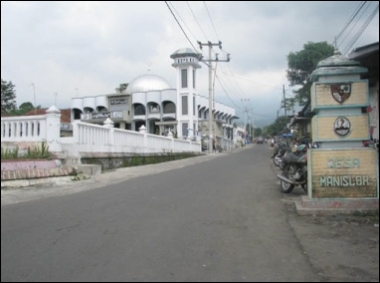SPECIAL REPORT Mon, 01/17/2011 9:23 AM |
Manislor, the largest Ahmadiyah ghetto
The Jakarta Post

Into the war zone: The Al-Huda mosque in Manislor village in Kuningan regency, West Java, stands at the entry into the village in this photo taken early this month. The village, where 2,000 Ahmadis live side by side with more than 1,000 other villagers, is the epicenter of the unfolding tragedy of discrimination against the minority. JP/Arghea Desafti Hapsari
The province is home to the largest population of Ahmadiyah followers in the country, and the epicenter of this unfolding tragedy is Manislor village in Kuningan regency, where 2,000 Ahmadis live side by side with more than 1,000 other villagers.
The Ahmadis have witnessed angry mobs forcing their way into the village to attack and seal off their mosque and houses, but to no avail. This has not happened only once, but four times.
“This village has the largest number of Ahmadis in one location. So it makes us a big glowing target for hardliners,” Nurahim, the secretary-general of Manislor’s Ahmadiyah community, said.
“The hardliners think that if they can take down the biggest group, it would be easier to quash smaller ones.”
Ahmadiyah first spread to the four hamlets of Manislor in the 1950s when village elders attended a discussion on Ahmadiyah in Cirebon, located an hour’s drive from Kuningan.
“They wanted to learn more about Islam so they invited a cleric to the village to teach locals,” Nurahim said.
The arrival of the cleric changed the face of Manislor.
“Manislor in the 1950s was very underdeveloped. It was poor and the villagers practiced animism. They worshipped trees and performed shamanist rituals,” Nurahim said.
“But this all ended when Ahmadiyah spread to this village. Villagers were taught to think more about religion, traditions and social issues,” he said.
The villagers began to abandon their animist ways, paving the path for Ahmadiyah to develop rapidly since 1954, with more and more locals taking up the faith.
Today, villagers who identify as Ahmadis outnumber other residents.
Despite decades of living peacefully despite theocratic differences, no physical confrontations had ever erupted until August 2002 when Islamic hard-line groups from outside the village launched a concerted attack on the Ahmadis.
The incident began when a Muslim youth group in Kuningan attended a seminar on Ahmadiyah at Istiqlal Mosque in Jakarta and returned to the city to stage a protest in Manislor, claiming the Ahmadis were heretical.
Two months later, the group attacked several houses and two small Ahmadiyah places of worship in the village.
Since then, the Kuningan administration has been bombarded by almost constant pressure from various groups to ban Ahmadiyah and evicted the Ahmadis from the village.
The hard-line groups and the Ahmadis frequently lobbied local authorities, each looking to get their demands met, but to no avail.
Manislor villagers have become accustomed to the ever-present tension and carried on with life as usual.
“We’ve experienced so many attacks I lost count. I think we’ve probably been attacked every year since the [2002] attack,” Siti Mudiati, an Ahmadi villager in Manislor, said.
She said the first attack left her traumatized, but as the attacks gained in frequency, she became more inured to them.
But other villagers are not as enduring as Siti. Ayu, who is not an Ahmadi, remains gripped by fear when hardliners appear at her village.
Her house is located between an Ahmadiyah mosque, An-Nur, and the village mosque, Al-Huda, which is used by non-Ahmadi villagers.
“What can I do? It’s not like I can stop the mobs or move my house somewhere else,” she said.
Manislor, a village located at the foot of the Ciremai hills, still bears traces of the latest attack that occurred in July last year.
Several houses along the main street are still plastered with signs reading “members of the Al-Huda mosque, followers of Prophet Muhammad” on their front walls to let attackers know that they are not the targeted Ahmadis. Ayu displays the sign in her window.
Al-Huda sits 150 meters from the An-Nur mosque, which is the center of the Ahmadis’ religious life in Manislor.
Not far from An-Nur is a cooperative run by the Ahmadiyah office in Manislor. Nurahim said the cooperative provided services ranging from granting loans, and electricity and phone bill payment facilities to courier services.
The Ahmadiyah organization in the village also runs a junior high school with around 230 students.
In another hamlet, Siti and 20 other housewives gather to make snacks and handicrafts to be sold at local food stalls and shops.
Ahmadis gather at the An-Nur mosque every Friday for noon prayer and every Wednesday and Sunday when they hold regular religious studies.
As an important part of Ahmadi life, the mosque has been a target of repeated attacks.
In October 2004, a public gathering was held at the Al-Huda mosque, which was attended by members of an Islamic hard-line group.
After the event, a large crowd was mobilized in Manislor and attacked the An-Nur mosque. The attackers demanded that the sect be broken up and its activities terminated.
In July 2005, the Indonesian Ulema Council (MUI) issued a fatwa declaring Ahmadiyah a deviant faith and called on the government to ban it. The fatwa was a reiteration of a previous fatwa issued in the 1980s.
On July 29, a day after the fatwa, the Kuningan administration shut down the An-Nur mosque and seven smaller Ahmadi places of worship in Manislor. Other facilities run by Ahmadis were also closed off, including the school.
Pressure on the Ahmadis in Manislor intensified on Dec. 18, 2007, when a large crowd damaged a small Ahmadiyah mosque and dozens of houses.
The Ahmadis, however, stood their ground, defending their house of worship. Both sides threw rocks and four people were injured in the incident.
But the worst insult to the villagers occurred on July 26, 2010. Local officials and dozens of public order officers came to Manislor to shut down the iconic An-Nur mosque.
After heated debate between the Ahmadis and officials, the latter decided to leave the village without sealing off the mosque.
However, two days later, the Ahmadis woke up to find their mosque sealed off with planks of wood and chains.
On July 29, the Al-Huda mosque held a mass prayer, after which hundreds of outsiders tried to force their way into Manislor to support the officials’ closure of the Ahmadi mosque.
Police halfheartedly attempted to stop them, resulting in clashes and rock throwing, with houses damaged and several people injured in the incident.
- JP/Arghea Desafti Hapsari








